If you're looking for authoritative information on sex video xnxxhow much cooling is enough for your CPU, you'll be hard-pressed to find an answer. While we all know that modern processors need some degree of active cooling, very little official information exists to say how different temperatures affect a CPU's performance.
Editor's Note:Older CPUs would simply fail if they started to overheat, but modern CPUs adjust their frequency based on temperature (among other things) to prevent a dramatic failure. Because of this, it stands to reason that once you reach certain temps, you will no longer be getting the maximum performance from your CPU because it will be busy protecting itself.
But what is that temperature? And do you really need a high-end liquid-cooled system to get peak performance, or is the little stock cooler that comes with most CPUs enough? In this article we will answer these questions and more.
Modern CPUs are able to adjust their operating frequencies through a number of technologies in order to either reduce their power consumption or provide maximum power as needed. The first of these modern technologies is Turbo Boost (or Turbo Core for AMD APU/CPUs). According to the overview page for Intel Turbo Boost Technology 2.0, there are five factors that affect the amount of increased frequency an Intel CPU can achieve via Turbo Boost:
For this article, processor temperature is the main factor we are concerned about. You would expect Turbo Boost to slowly stepping back the amount of Turbo Boost as the CPU gets hotter. In actuality, an Intel CPU under heavy load will actually run at the maximum Turbo Boost allowed by the other four factors until it hits the CPU's thermal limit.
CPUs also have extremely robust thermal protection. If the CPU starts operating above the CPU's thermal limit it will begin to reduce the frequency in order to prevent catastrophic failure. Oddly, we have found that the thermal limit for both Turbo Boost and thermal protection on Intel CPUs to be right at 100 °C - which makes it very convenient to remember. In other words, until the CPU hits 100 °C you should see 100% of the CPU's available performance. Once you starting hitting 100 °C, however, the CPU will start throttling back to keep itself from overheating
We know from both experience and explicit testing that modern Intel CPUs (at the very least Sandy Bridge, Ivy Bridge, and Haswell) can run at their maximum Turbo Boost frequency all the way up to 100 °C. While there may be a tiny performance difference between a CPU running at 30 °C and one running at 95 °C, our testing has found that the difference is miniscule. In fact, even after running benchmarks dozens of times the difference is so small that it is essentially nonexistent.
What we canmeasure is what happens once a CPU starts to hit 100 °C. To figure this out, we took an Intel Core i7 4790 and cooled it with a Gelid Silent Spirit Rev. 2 CPU cooler that was connected to a manual PWM fan speed controller. By running Linpack (which is a CPU benchmark widely used in the scientific community) and slowly dialing the fan speed down in careful increments, we were able to allow the CPU to overheat by incremental amounts. At each cooling increment we kept a log of the Linpack benchmark results as well as using CoreTemp to record the CPU core temperature and frequency.
Since the Intel CPU thermal limit is 100 °C, we can quantify the amount of overheating by measuring the amount of time the CPU temperature was running at > 99 °C.
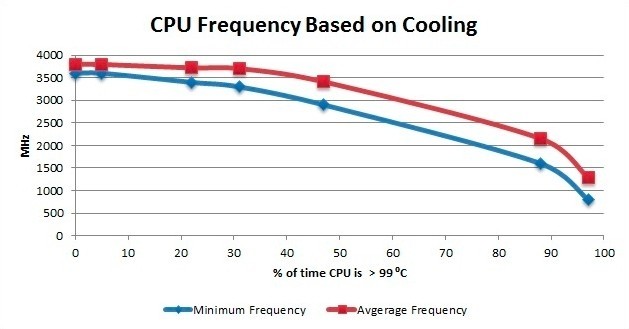
We were very surprised when our testing showed that while the minimum CPU load frequency started to drop as soon as the CPU hit 100 °C, the average CPU frequency didn't drop by more than .1GHz until the CPU was overheating more than 30% of the time. In fact, Intel CPUs are surprisingly good at being able to handle this much heat with such a small reduction in the average frequency.
While this is a great way to understand what is happening from a frequency standpoint, we wanted to know how this affects real-world performance. To do so, we recorded the Linpack performance results to see what the actual performance implications of overheating are:
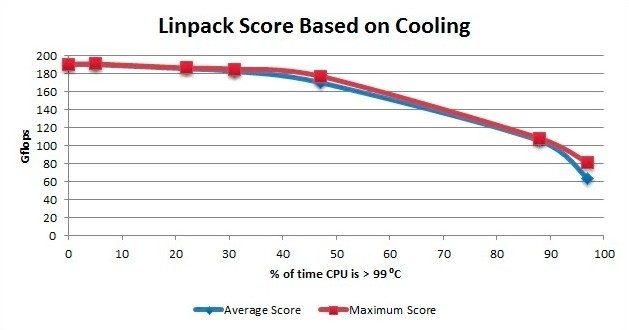
Linpack is one of the most consistent CPU benchmarks we have ever seen and the Intel Core i7 4790 should score right at 190 GFlops with the problem size we used for this testing (30000). What is interesting is that the Linpack results from our testing almost exactly follow the average CPU frequency from the previous graph. While it makes complete sense, this pretty much just confirms that from a strictly CPU performance point of view, the performance of a CPU is directly related to it's average frequency.
So what does this all mean? Beyond the fact that Intel CPUs are impressively stable even while technically overheating it means that you can expect full performance from an Intel CPU as long as you keep it below 100 °C. At the same time, even if the CPU occasionally hits 100 °C you shouldn't see more than a minimal drop in performance until it spends a significant amount of time (more than 20% of the time) above 99 °C.
While the information from the previous section is really interesting, it may be hard to translate into a real world situation. To help with this, we performed the exact same Linpack test except that instead of altering the cooling manually we used two different CPU coolers - the stock cooler that came bundled with the Core i7 4790 and the budget-friendly Cooler Master Hyper TX3 which only costs about $20. To make this as real-world as possible, we installed our test hardware (Asus Sabertooth Z97 Mark II, Intel Core i7 4790, 4x Kingston HyperX LoVo DDR3-1600 4GB, NVIDIA GeForce GTX 980) into a Fractal Design Define R4 chassis with the stock fans running at 5V.
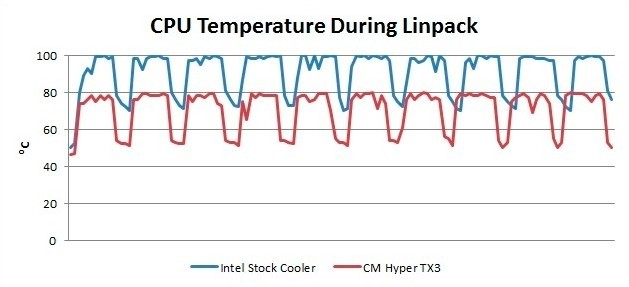
As you can see from the graph above, even a very affordable CPU cooler like the CM Hyper TX3 is able to dramatically lower the CPU temperature under load. While the stock cooler is easily hitting 100 °C during the benchmark run, the CM Hyper TX3 only ever hits a maximum temperature of 80 °C. In terms of how much the CPU was overheating, the stock cooler allowed the CPU to run at > 99 °C about 20% of the time.
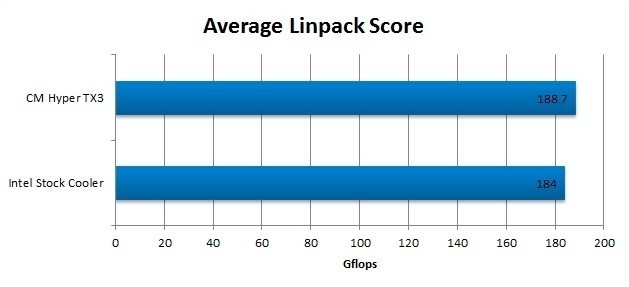
According to our graphs from the previous section, we should expect a measurable, albeit small, drop in performance with the stock cooler. We found that using the stock cooler made the CPU perform about 2.5% slower than it did with the CM Hyper TX3. The neat thing is that this drop in performance almost exactly lines up with our graphs of expected performance from the previous section.
The results of our testing can pretty much be summarized with the following three points:
Frankly, we were a bit surprised at how well modern Intel CPUs dealt with really high temperatures. They manage to run at full speed all the way up to 100 °C, and even then the performance is not greatly affected unless they spend a significant amount of time at that temperature. We certainly don't advocate letting your CPU run at those kinds of temperatures, however. While this article is about performance there are plenty of non-performance based reasons to keep your CPU temperature at a more reasonable level.

Sensitive electronics like CPUs have a finite lifespan and running them at higher temperatures shortens it. So unless you want to have an excuse to upgrade your system often, higher temperatures are counter-productive.
With PC hardware, higher temperatures make both minor and major hardware faults much more likely. These hardware faults can result in anything from reduced performance due to minor errors needing to be corrected to data corruption or bluescreens due to more dramatic errors.
The difficult thing is that just saying "lower temperatures are better" is an overly simplified way to look at CPU temperatures when you consider a PC as a whole. While you canuse giant liquid cooling loops, insanely high flow fans, or even things like liquid nitrogen to keep a CPU extremely well cooled those methods are either expensive, cumbersome, loud, or a combination of all three. In reality it is generally better to let the CPU run a little warm in order to properly balance the cooling against the heat output of the CPU.
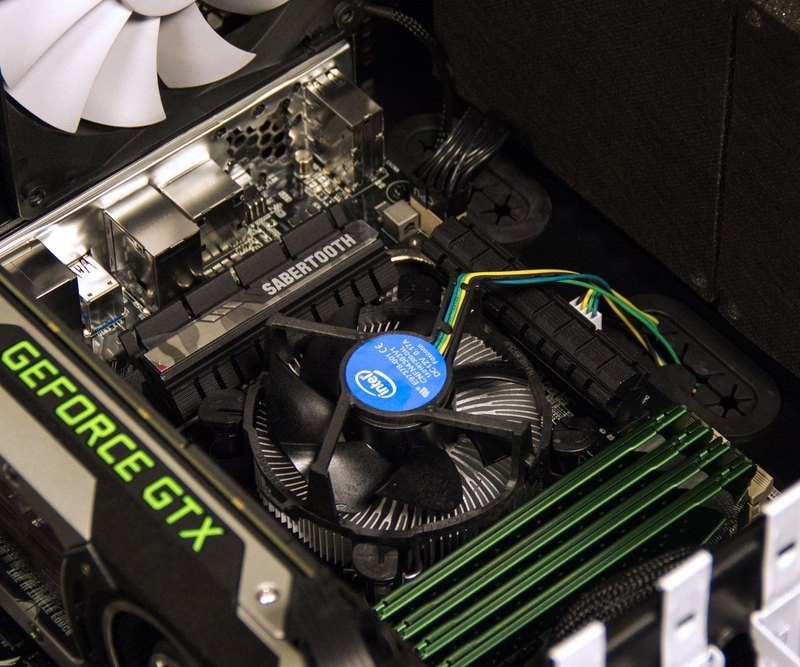
For example, the Corsair Hydro H60 is a great closed-loop CPU cooler used on most of Puget's high wattage CPUs, but it would be overkill for a low-wattage Intel Core i3 CPU. It would certainly keep the CPU well cooled, but it would be much louder, more complex (due to the liquid and pump), and more expensive than what is necessary. Instead, a CM Hyper TX3 or Gelid Tranquillo (if you want to have the system even quieter) would be a better match for that CPU even though the CPU would run slightly hotter under load.
For the average system, a rule of thumb at Puget Systems is that the CPU should run around 80-85 °C when put under full load for an extended period of time. This gives the CPU plenty of thermal headroom, does not greatly impact the CPU's lifespan, and keeps the system rock stable without overdoing it on cooling. Lower temperatures are, of course, better (within reason) but if you want a target to aim for, 80-85 °C is what we generally recommend.
 Elon Musk makes it more expensive to own a Tesla
Elon Musk makes it more expensive to own a Tesla
 This company has spent the evening correcting Donald Trump's claims
This company has spent the evening correcting Donald Trump's claims
 British Twitter explains what it means to be British with hilarious hashtag
British Twitter explains what it means to be British with hilarious hashtag
 DuckDuckGo's private searches will pull up Apple Maps results
DuckDuckGo's private searches will pull up Apple Maps results
 Elon Musk makes it more expensive to own a Tesla
Elon Musk makes it more expensive to own a Tesla
 Snap's new problem: disappearing executives
Snap's new problem: disappearing executives
 Elon Musk's space Tesla actually served an engineering purpose
Elon Musk's space Tesla actually served an engineering purpose
 'New Super Mario Bros. U Deluxe' is the best game I've ever despised
'New Super Mario Bros. U Deluxe' is the best game I've ever despised
 Best robot vacuum deal: Save $400 on the roborock Q5 Pro+
Best robot vacuum deal: Save $400 on the roborock Q5 Pro+
 Watch Katy Perry valiantly attempt to vote nude in new video
Watch Katy Perry valiantly attempt to vote nude in new video
 This resurfaced video of *NSYNC doing the Pokémon rap is so cringeworthy it's perfect
This resurfaced video of *NSYNC doing the Pokémon rap is so cringeworthy it's perfect
 LG to launch a phone with a detachable secondary screen, report claims
LG to launch a phone with a detachable secondary screen, report claims
 NYT Connections Sports Edition hints and answers for March 4: Tips to solve Connections #162
NYT Connections Sports Edition hints and answers for March 4: Tips to solve Connections #162
 The Face ID ruling is a big win for digital rights. Here's what needs to happen next.
The Face ID ruling is a big win for digital rights. Here's what needs to happen next.
 A tennis match ran until after 3 a.m., and you have to admire these sleepy fans
A tennis match ran until after 3 a.m., and you have to admire these sleepy fans
 #TrumpWon trends in the morning after the debate — with plenty of laughter
#TrumpWon trends in the morning after the debate — with plenty of laughter
 Google's new AI model is being used to remove image watermarks
Google's new AI model is being used to remove image watermarks
 Comfort bingeing TV shows is one of life's more transcendent pleasures
Comfort bingeing TV shows is one of life's more transcendent pleasures
Ryan Reynolds trash talks Karen Gillan over fantasy football, gets a brutal responseVirgin Orbit's historic UK launch fails due to 'anomaly'Vegan dating app Grazer has 'f*** vegans' Veganuary campaignHow recording myself crying helped me be kinder to myselfThe mannequin head meme has Twitter shakingCan of dry shampoo explodes in hot car, breaking sunroofHalloween candy battle royale fight is splitting Twitter apartTrump loses it over hyphens and apostrophes while avoiding his real problemsSAG nominations 2023: Full list'Quordle' today: See each 'Quordle' answer and hints for January 1510 dogs who really loved their puppucinosChrissy Teigen accidentally leaks her email address on Twitter, styles it outChrissy Teigen accidentally leaks her email address on Twitter, styles it outRyan Reynolds trash talks Karen Gillan over fantasy football, gets a brutal responseCan of dry shampoo explodes in hot car, breaking sunroofMike Pompeo awkwardly accepts a block of cheese from Italian reporterJonathan Van Ness freaking out over a call from Elizabeth Warren will make your dayWordle today: Here's the answer, hints for January 16'The Last of Us' does what 'Andor' failed to doTim Cook might get huge pay cut in 2023 New Zealand police radio hacked to play NWA's 'F**k tha Police' MashReads Podcast: New Year reading and 2018 book goals Kodak announces its own cryptocurrency and sees shares rocket Google fires another shot at Amazon with new 'smart displays' E! president responds to Catt Sadler pay gap controversy — and oh boy Delete the Facebook app off your phone right now Actress Mira Sorvino apologizes for working with Woody Allen FoldiMate's laundry Spyware creator arrested for allegedly creeping on thousands for 13 years Facebook's newest tested feature pushes local news and events Schlage Smart Deadbolt integrates Alexa, Siri, now Google Assistant Tom Hardy's first 'Venom' photo is of a wholesome Eddie Brock Vivo creates first in Ivanka Trump praised Oprah's Globes speech but people aren't having it The Central Hall at CES 2018 just lost power, and people cheered Facebook teams up with Xiaomi, Qualcomm on new Oculus Go VR headset Gillian 'Scully' Anderson is officially leaving 'The X Razer unveils Project Linda, a laptop dock for your Razer Phone Uber and Bell Helicopter show off passenger drone concept at CES 2018 Kohler announces Amazon Alexa
1.8455s , 10567.2421875 kb
Copyright © 2025 Powered by 【sex video xnxx】,Co-creation Information Network